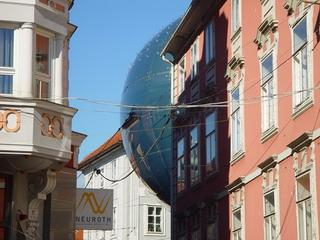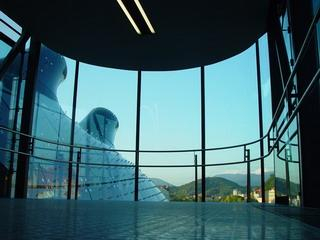Kunsthaus Graz
Located in the centre of Graz, this museum for contemporary art was opened in September 2003, the year in which the city was designated the European Cultural Capital. Its remarkably well-preserved historical centre, dating primarily from the Renaissance and Baroque eras, has resulted in its classification by UNESCO as a World Heritage City. The buildings external appearance is highly iconic with its striking biomorphic geometry and blue acrylic skin that establishes a deliberate contrast with this historical fabric. Yet, paradoxically, the project was conceived to fit quite smoothly, in terms of its scale and urban activities, within its surrounding environment, hence its nickname of the friendly alien.
The museum does not have a permanent art collection and so the building is designed internally as a flexible multipurpose platform that can be reconfigured for each temporary exhibition. The general design concept is a simple one, consisting essentially of two main exhibition spaces: a top deck which offers partial natural lighting provided by a number of north-facing skylights (referred to as nozzles) and an artificially lit lower deck used mainly for multimedia installations.
These two decks are raised above ground and wrapped in a continuous double-curved surface that spans over the upper deck, down the sides as well as under the belly of the lower deck, thus blurring the customary typological distinction between roof, walls and floor. The skin provides protection of the building from the external environment, allows some natural light and outside views, and also acts as an electronic display system that can be programmed to show text, fixed images, animations or video.
The new structure is connected by means of two bridges with the Eiseneshaus, a listed 19th-century cast-iron building that has been rehabilitated and converted to house the museum shop, an electronic media centre, administrative offices, etc.







.jpg)
